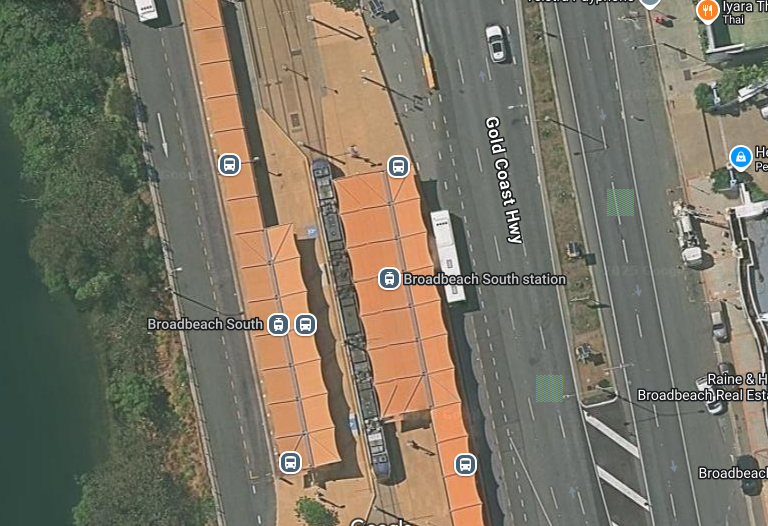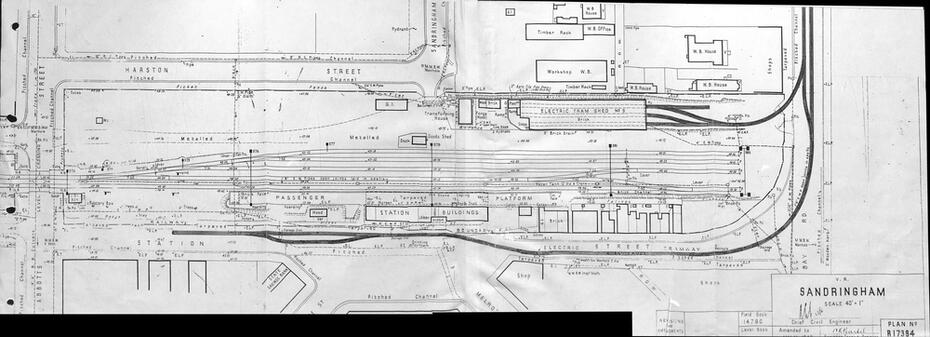I was motivated to write this post after a recent trip to the Gold Coast in Queensland.
There, as in many other places, they use what are called cross-platform interchanges – something that is mysteriously absent in Melbourne.
Put simply, this is where you can get off one public transport vehicle and move to another without having to change platform. There are many benefits to this design that we’ll go through here.
Cross-platform interchanges in states that are not Victoria
To start with the Gold Coast, the southern terminus of Stage 1 is Broadbeach South on the Gold Coast Highway near Pacific Fair Shopping Centre. This is also a major bus interchange with most routes in the city stopping or terminating here.
They took the opportunity to upgrade bus routes when the first section of G:Link opened in July 2014. This included bringing buses to the new Broadbeach South tram stop which was specifically designed for this purpose.
You can see in the aerial diagram below how the stop is laid out. It is essentially two parallel island platforms, each with tram and bus access on either side.

What this means is a very easy and quick interchange between buses and trams. It requires almost no signage or explanation to get off the bus or tram and see the other side of the platform directly in front of you. This is particularly important for the 777 and 777X buses that operate to Gold Coast (Coolangatta) Airport and carry thousands of tourists and other visitors who transfer onto the light rail to travel north towards Surfers Paradise.

It’s a well thought-out design that is intuitive and functional.
But the Gold Coast is far from the only place in Australia to make use of this simple yet effective layout.
Another example includes Chatswood Station which offers an intermodal cross-platform interchange between the Sydney Trains and Sydney Metro systems.

While we’re on the topic, why limit ourselves to inner-city locations?
I always found Adelaide to have some of the best-designed train-bus interchanges in the country. There is certainly room for improvement but the very utilitarian approach of South Australia to its rail infrastructure can have its benefits.
Elizabeth Station in the north of Adelaide is the perfect example. It is a relatively busy station servicing a major suburban centre, including several bus routes.
Up (citybound) trains stop at the same platform as the bus interchange. Assuming you exit at the right door and your bus is waiting, you can be off the train and on the bus in a matter of seconds. You can see from about 6:23 onwards in this video how the bus and Up train services are on the same platform.
This video below gives a different perspective of this arrangement.
This was built in 2012 during a station upgrade and was not by accident. It was a design specifically built to facilitate these interchange opportunities. This 2011 Public Works Committee report from the Parliament of South Australia outlines the details.
This brings us to the question – why not Melbourne?
Why not Melbourne?
It seems to me that we have surprisingly few multi-modal cross-platform interchanges in Melbourne as a proportion of our overall network.
Some of the stops or stations with anything resembling these of which I’m aware in Melbourne are:
- Moonee Ponds Junction (tram – bus)
- Anzac Station (not yet open, tram – train)
- Parkville Station (not yet open, tram – train)
- Casino East / Queens Bridge Street (tram – bus)
- Vermont South (tram – bus)
- Clifton Hill (train – bus)
- Sandringham Railway Station (train – bus)
- Ringwood, Caulfield, Camberwell and various other interchange stations (train – train connections)
(Pre-empting the comments section, this is not an exhaustive list).
Really I’m grasping at straws here because none of the above are truly cross-platform. For example, changing from the 82 tram to any bus requires crossing at least one service road and it is not the same platform as buses. Anzac Station doesn’t require crossing any roads but the train platform is 22 metres underground and not the same one as for trams. Vermont South interchange is close but is not part of the same platform, similar to Moonee Ponds. All the train-train interchange railway stations also only service one direction and are not intermodal.
Queens Bridge Street next to the Yarra River is a situation where trams and buses share the same platform. It may count but technically isn’t an interchange across multiple platforms as both modes stop in the one place.
I have no definitive single answer as to why these are so rare in Melbourne but I believe it’s a combination of historical precedent and deliberate design.
On the first point, Melbourne’s public transport has a history of fragmentation. Going back a hundred years, you had tram companies not only competing with railways for passengers but with each other in some places. This created legacy issues that we still live with today. Perhaps most famously tram routes 3 and 5 terminate just short of nearby railway stations.
We have also not had the same intermodal oversight bodies in the past that other networks have had. These need enough funding and authority to build this kind of infrastructure and make these decisions.
The other main reason why these opportunities are not taken with new stations is where elements of infrastructure design are dictated by the aim of reducing fare evasion and operating costs. Many of the inconveniences and ‘quirks’ of Melbourne’s stations can be explained by this practice.
The basic thinking is that the fewer entrances available the easier it is for a group of Authorised Officers to stand and check tickets as people enter or leave the station. And where it is a staffed station with myki gates, this reduces the number of staff required and reduces costs.
Perhaps the worst and most famous offender for this is Richmond Station. It has two of its four entrances closed for most of the time and significantly reduce access to the platforms. The southern and northern entrances on the west side of Punt Road are only open during some (but not all) events at Melbourne and Olympic Park, and the northern entrance on the east side is only open from 4:30am to 7:30pm on weekdays.

Most frustrating is the lack of entrances at brand new stations and blocked off entrances at older ones. Marcus Wong and many others have written on this topic before.
It’s not just about the entrances and interchanges per se. When these are blocked off there is a lot of fencing installed. This often prevents what could otherwise be a much easier, safer and quicker intermodal interchange. There are a handful of instances like Prahran and Lilydale where more entrances were added to an existing station but these are very much exceptions.
Even some brand new infrastructure in Melbourne did not take the opportunity to create a direct connection to bus stops on both sides of a busy road is not taken. You can see Bell, Keon Park and Springvale Stations.
As ‘Thomas the Think Engine’ puts it, “This is not a passenger-centric design, but an operator-centric design.“
The final but far less common main reason I can cite is commercial. This was probably the main rationale that destroyed the direct entrance from the Swanston Street / La Trobe Street tram stop into Melbourne Central Station when it was refurbished in 2004.
All of these reasons seem to be literal and figurative barriers to having cross-platform or otherwise much easier intermodal interchanges here in Melbourne.
Close but not quite
I think that the closest thing that Melbourne has to a cross-platform intermodal interchange is at Sandringham Railway Station.

Ironically the reason it exists today is because of the former Sandringham Tramway. It opened in 1919 and was operated by Victorian Railways. For this reason it integrated seamlessly with the train service, which was also upgraded to electric traction in the same year. Because the tram and train were operated by the same organisation, this resulted in better coordination, unlike the examples above.
Even though the tram is long gone, we benefit from this integration today. The bus stops are directly outside the station entrance. If you pick the right door on the train, you can be out and on a waiting bus in 10-15 seconds.
But this only works well if you pick the right door on the train. This is because ever since the station was built in 1887, it seems to have had a fence blocking access to the platform except through the ticket hall. You can see one in this early 1900s photo and even here in 1953 well after the tram opened. Obviously this is not just a recent problem!
Cross-platform interchanges are still a rare breed in Australia and it’s not for a lack of need or opportunity. The good news is that the organisations designing some of our modern infrastructure are recognising their usefulness and including them in some new stops and stations. Hopefully this trend continues.



Leave a Reply